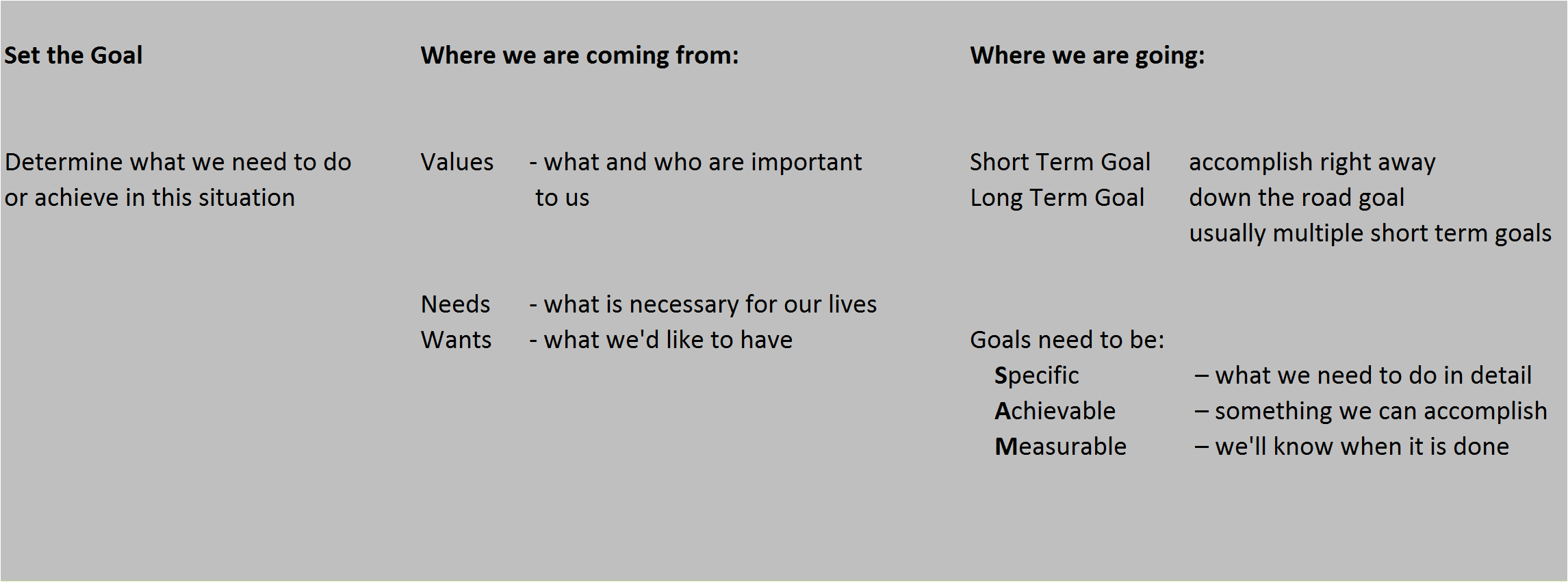Thresholds Six Steps
Define or Understand the Situation
To move forward in life, we need to know where we want to go. To do this we need to know where we are and why we’re at this point. The symbol. for this first step is an encircled ‘S’, a reminder to focus on one particular situation. How did we get in this situation? Was it chance, or something we assumed, or a reaction to someone else, or was it our choice among several things.
What are our feeling or thoughts or goals in this situation? What memories does this trigger?
What are the people, places, and things that affect us in this situation? These are included in our situation as well.
Step One gets us to slow down and examine these elements of a particular situation.

Set a Goal
Now that we have an idea of our situation, what do we want to do, to be, or to have. What is our goal? If our approach to deciding on a goal is to take the first thing that comes to mind, we can be disappointed or frustrated. We understand that goals are personal, and need to be in touch with what is important to us, to what we value. Goals focused on what we need and require, move us along more than goals focused on wants or desires. This takes some thought.
Goals can be easily reached or may take some time and effort. Long term goals may seem overwhelming and beyond our reach, but developing short term goals enable us to accomplish those long term ones in parts.
If we are not use to creating and reaching goals, it can be difficult to know what goals are realistic and which are not. The memory aid ‘SAM’ , can be used to see if goals are specific, achieveable, and measurable.

Develop Possibilities to accomplish the goal
Just as there is more than one way to cook an egg, so there is more than one way to reach a goal. To jump on the first idea limits the likelihood that our goal will be reached. So, we need to come up with as many ideas/possibilities as we can. We don’t want to limit ourselves by falling into mental traps we can set. A memory aid for ways that we block ourselves from new ideas is ‘JAM’, Jump to conclusion, repeating actions Again and Again, and believing Myths handed on by others.
To generate new ideas and possibilities we’ll need to put effort into Accumulating information, Brainstorming with others, and Considering alternative ideas, i.e. thinking outside the box. This ‘ABC’ process enables us to be open to more possible ways to reach our goals. More possibilities translates to more likelihood of a successful outcome.

Evaluate the Possibilities
Now that we have a list of possible ways to reach the goal, we’ll need to focus on which ideas are more likely to get us to the goal. To see these possibilities in black and white, we get a better grasp of what each one entails. Listing these on paper, we give each possibility a rating on how likely we can do it. We also rate it on drawbacks, on how it may limit us reaching the goal. In addition we may want to see the effect that a possible choice has on family or friends.
Using this method we can narrow the choice to which idea is most desirable and least risky in reaching our goal. With a number rating for each possibility, and a risk rating for each, we’re now better able to see that choice stand out clearly in comparison to the others.

Make the Decision
A Decision is a choice among several alternatives. We’ve done an evaluation of our possibilities and picked the choice best suited to reach the goal. We’ve made our decision. We haven’t reacted to get to this choice. No one has forced us to make this choice. It is our own freedom to choose that we are using. We are willing to be responsible for the consequences, good or bad. We’ll need to be committed to make this choice a reality.
Choosing one possibility over others makes this a decision. Personal freedom is at the heart of this capability. By making decisions we gain greater confidence when we encounter other situations in life.

Implement the decision
A choice without committment is but a wish. To carry out a decision, like any task, we require a plan of action. A helpful way for us to do this is to list the steps needed to reach our goal. We start by writing down the individual actions to be done, from the point of preparation to the end point of reaching the goal. Then we put the activities in logical order so we can act on them in sequence. Finally we give each action a time frame so we know when it is supposed to start. Now we have a clear map of what we need to do to accomplish our goal
Many of life’s happenings can distract us from our goal. A reminder or symbol can help to keep us on track. Pictures, magnets on the fridge, or a related song can re-energize us. This can keep us on the road to reaching the goal.
Whether the goal is reached in the planned timeframe or not, reviewing what actions we took can give us insights into what works or doesn’t work when a particular goal is set.

